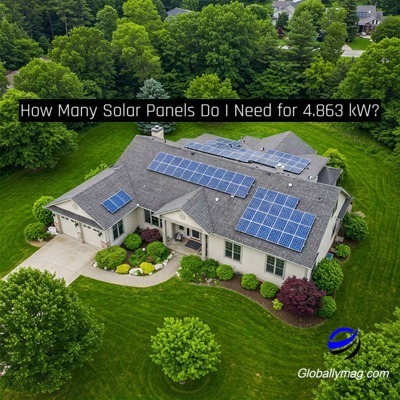How many solar panels do you need to achieve 4.863 kW?

Introduction: Let’s Shine a Light on Solar Energy!
Solar energy is an increasingly viable solution for homeowners keen on reducing utility costs while contributing to a cleaner environment. As the transition towards renewable energy accelerates, many households are exploring how solar energy can minimize their carbon footprint and save on electricity bills.
According to a recent 2023 study by the National Renewable Energy Laboratory (NREL) titled Photovoltaic Solar Energy Generation, households with a 4.863 kW solar system experienced an impressive 65% reduction in their electricity bills within just one year! This staggering statistic has inspired over 3.5 million homes across the U.S. to adopt solar power solutions. Whether residing in a modest apartment or an expansive suburban home, solar energy could be the key to achieving lower electricity bills and a more sustainable planet.
In this guide, we will explore crucial aspects of solar energy, including how to calculate your energy needs, the specifics of solar panels, and essential information regarding installation and financing options.
Quick Answer: How Many Solar Panels Do You Need?
If you’re considering a solar system around 4.863 kW, the number of panels you’ll require primarily depends on the wattage of the solar panels selected:
- 500W Panels: About 10 panels needed.
- 250W Panels: Roughly 20 panels.
- 350W Panels: Approximately 14 panels.
- 405W Panels: Close to 12 panels.
Opting for higher wattage panels can reduce the total number of panels required, simplifying installation and potentially lowering costs. For further insights on solar panel choices, check out resources like EnergySage.
Planning Your 4.863 kW Solar System
A. Assessing Your Energy Consumption
Interpreting Your Electricity Bill
Understanding your energy usage is essential. A kilowatt-hour (kWh) measures electricity consumption; for instance, a 100-watt bulb running for 10 hours uses 1 kWh. Your electricity bill offers insights into monthly energy habits and can help determine your needs.
Estimating Your Usage
Here’s a breakdown of common household appliances and their average energy consumption:
| Appliance | Wattage | Hours/Day | Daily kWh | Annual kWh |
|---|---|---|---|---|
| Air Conditioner | 3,500 | 6 | 21.0 | 7,665 |
| Refrigerator | 150 | 24 | 3.6 | 1,314 |
| LED Lights | 10 | 5 | 0.5 | 183 |
| Total | 25.1 | 9,162 |
On average, an American household consumes about 877 kWh/month, but individual consumption can vary significantly based on lifestyle and appliance use.
Pro Tip: Utilize the NREL’s PVWatts Calculator to refine your energy generation estimates based on your location and seasonal sunlight.
B. Is a 4.863 kW System Right for You?
Energy Consumption Averages in the U.S.
According to the U.S. Energy Information Administration (EIA), average households consumed around 877 kWh monthly in 2023. A 4.863 kW solar system can offset 550 to 700 kWh/month, allowing you to save enough to fund various goals!
Tailoring to Your Needs
If your household consumes around 900 kWh/month, consider investing in energy-efficient appliances or designing your solar system with an additional 10-20% capacity. This helps accommodate future energy needs, such as charging an electric vehicle.
C. Understanding Solar Panel Specifications
Familiarizing yourself with solar panel specifications aids in making informed decisions. Here’s a breakdown:
| Panel Type | Wattage | Efficiency | Temperature Coefficient | Cost/Watt | Lifespan |
|---|---|---|---|---|---|
| Monocrystalline | 405W | 20-22% | -0.37%/°C | ~$3.10 | 25-30 years |
| Polycrystalline | 350W | 15-17% | -0.40%/°C | ~$2.50 | 20-25 years |
| Bifacial Panels | 500W | 22-24% | -0.35%/°C | ~$3.50 | 30 years |
| Thin-Film | 300W | 10-12% | -0.20%/°C | ~$1.50 | 15-20 years |
While monocrystalline panels are known for high efficiency, bifacial panels can capture sunlight from both sides, providing increased energy generation in reflective environments. For more detailed comparisons, refer to EnergySage guides.
D. Factors Influencing Solar Output by Location
Your geographical location significantly affects solar energy production. Here’s a look at annual outputs for select U.S. cities:
| City | Annual Output (kWh) | Percentage of Energy Needs Met |
|---|---|---|
| Phoenix, AZ | 7,200 | Up to 90% |
| Houston, TX | 5,800 | About 70-80% |
| Seattle, WA | 4,500 | 50-60% |
Research indicates that approximately 85% of homeowners in sunny areas are satisfied with their solar systems. For insights on state-by-state solar production, check the Solar Energy Industries Association (SEIA).
Step-by-Step Calculation for a 4.863 kW Solar System
To assess your solar system needs, follow these four steps:
- Assess Monthly Energy Usage: Review your electricity bill.
- Understand Panel Capacities: Familiarize yourself with available wattage options.
- Calculate Required System Size:
System Size (kW) = Monthly Energy Needs (kWh) ÷ Average Sunlight Hours (hours/month) - Determine the Number of Panels:
Number of Panels = System Size Needed (kW) × 1000 (W/kW) ÷ Panel Wattage (W)
Combined Calculation Table for a 4.863 kW System
| Panel Type | Wattage | Formula | Number of Panels Needed |
|---|---|---|---|
| Monocrystalline | 405W | (4.863 kW * 1000) / 405W | 12 (rounded up) |
| Polycrystalline | 350W | (4.863 kW * 1000) / 350W | 14 (rounded up) |
| Bifacial Panels | 500W | (4.863 kW * 1000) / 500W | 10 |
| 250W Panel | 250W | (4.863 kW * 1000) / 250W | 20 |
Installation, Financing & Maintenance
A. Federal Tax Credit
If you’re considering solar, you can claim a 30% tax credit on installation costs on your federal tax returns. For instance, if your installation costs $48,630, you could qualify for a tax credit of $14,589. For more details, visit the IRS website to stay informed.
B. Net Metering
Net metering allows homeowners to earn credits for excess energy sent back to the grid, helping to reduce energy expenses. For localized information on net metering policies, check out the DSIRE website, which provides a comprehensive database of state incentives for renewables.
C. DIY vs. Professional Installation
When deciding between DIY installation and hiring professionals, here’s a quick comparison:
| Factor | DIY | Professional |
|---|---|---|
| Cost | Approx. $10k | Approx. $18k |
| Time | 3+ months | 6–8 weeks |
| Safety | High risk | Low risk |
A 2024 SolarReviews survey indicated that 90% of DIYers face permitting delays, which can increase costs and installation time. It may benefit you to leave it to professionals unless you prefer tackling a challenging project!
D. Maintenance Checklist
Routine maintenance is crucial for efficient operation. Here’s a basic checklist to follow:
- Monthly: Check inverter displays for alerts.
- Biannual: Clean solar panels with a soft brush to remove dirt.
- Annual: Schedule a professional inspection to ensure optimal performance.
Tools & Resources
Consider these useful resources to guide you in your solar adventure:
- NREL’s PVWatts: Estimate your expected solar output using their calculator. Visit PVWatts.
- EnergySage Solar Calculator: Evaluate potential savings and determine the right system size. Check EnergySage.
- Solar Installer Directory: Identify qualified installers in your area through trusted platforms like Solar Reviews.
Conclusion
Investing in a solar system can be a wise financial decision for homeowners across the U.S. Beyond providing direct savings on electricity bills, solar energy increases property value and offers energy independence. By utilizing reliable resources and seeking expert advice, you can enhance your solar experience and make educated choices.
If you’re ready to discover your solar options, explore how to assess your energy needs and find qualified solar installers in your area. Embrace the journey of solar energy and take control of your energy future!
FAQs
1. What is the average cost of a solar panel system in 2025?
The average cost for a solar panel system in 2025 ranges from $15,000 to $30,000, depending on system size, installation specifics, location, and local incentives.
2. How does net metering benefit solar panel owners?
Net metering allows homeowners to earn credits for surplus electricity generated by their solar systems. If your system produces more energy than you consume, the excess is sent back to the grid, resulting in lower future electricity bills.
3. What kind of maintenance do solar panels require?
Solar panels require minimal maintenance. Homeowners should clean them once or twice a year to remove dust and debris. Having them inspected annually by a professional ensures optimal performance.
4. How long can I expect my solar panels to last?
Most modern solar panels last 25 to 30 years, with many manufacturers offering warranties for that duration. Panels can continue generating electricity beyond this time, but efficiency may gradually decline.
5. Do solar panels perform well in cold or cloudy climates?
Yes, solar panels can efficiently produce electricity in colder or cloudier conditions. They often perform better in cooler temperatures and effectively capture diffuse sunlight on overcast days.
6. Is solar energy experiencing rapid growth globally?
Absolutely! The U.S. added over 28 GW of solar capacity in 2023, bringing the total installed capacity to more than 136 GW, enough to power approximately 25 million homes.
7. What are some recent advancements in solar technology?
Recent innovations include floating solar farms that minimize water evaporation while generating electricity and solar tracking systems that adjust to follow the sun, optimizing energy capture.
8. How does solar energy impact carbon emissions?
Installing one megawatt of solar power can prevent approximately 3,000 tons of CO2 emissions over 30 years, contributing significantly to environmental sustainability.
9. What are some unique applications of solar technology?
Solar technology includes applications such as solar roof shingles, solar window films, and portable solar chargers, demonstrating its versatility for residential and mobile use.
10. How many jobs does the solar industry provide in the U.S.?
The solar industry employed over 300,000 individuals in 2022, emphasizing its role as a growing sector in the renewable energy landscape.
11. Which state leads in solar energy adoption?
California leads in solar energy adoption, boasting over 57 GW of installed capacity, supported by favorable climate policies and financial incentives.
12. What tax incentives are available for homeowners installing solar systems?
The Federal Solar Investment Tax Credit (ITC) allows homeowners to deduct 30% of their installation costs from their federal taxes.
13. Are there specific state programs to promote solar energy?
Yes, many states offer additional incentives like rebates to encourage solar energy adoption.
14. What are community solar initiatives?
Community solar projects enable individuals without suitable roofs to purchase shares in solar farms, allowing them to benefit from generated electricity and receive credits on their utility bills.
15. What is the future outlook for solar energy in the U.S.?
By 2030, solar energy could account for over 20% of total electricity generation in the U.S., with projections estimating an increase of over 600 GW in solar capacity.
Now, let’s commit to embracing solar energy for a sustainable future! 🌞
